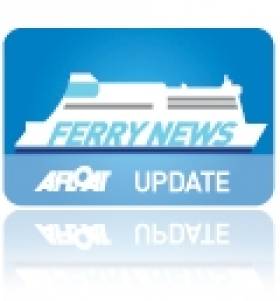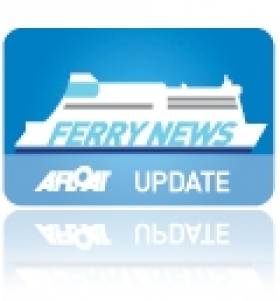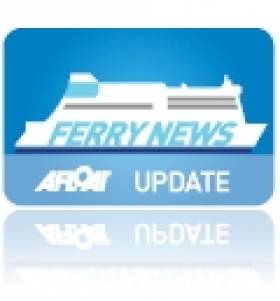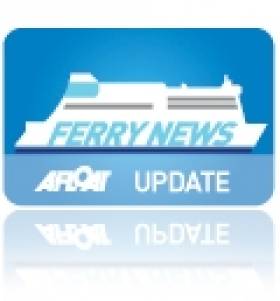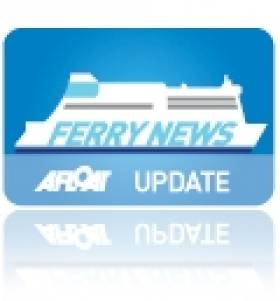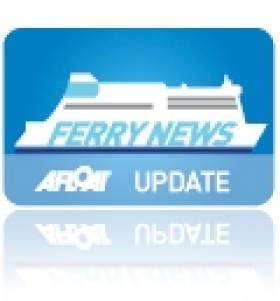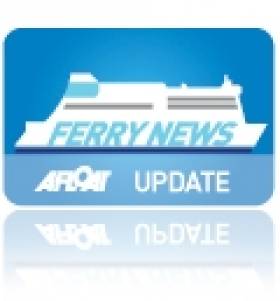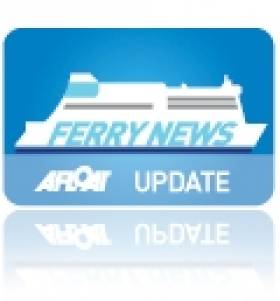Displaying items by tag: Stena Line
Stena Line Voted ‘Best Ferry Company’ by Irish Media
#FirstFerryAward – Stena Line became the first ferry operator to be voted in a new ferry category at the annual Blue Insurances Travel Media Awards.
The prestigious awards ceremony held in the Shelbourne Hotel, Dublin last week drew more than 170 guests and VIPS from the travel trade and media throughout Ireland. The annual awards were created to acknowledge outstanding performance in the travel and tourism industry.
Now in their third year, the awards comprised 21 categories which were voted for by a wide cross section of media in the Republic of Ireland and independently audited by the Department of Tourism at Dublin Institute of Technology.
Diane Poole OBE, Stena Line Head of PR and Comms UK and Ireland, accepted the award on behalf of the company commenting: "We are delighted to have been voted Best Ferry Company and it's particularly gratifying that these awards are voted for by the Irish journalists as they play a vital role in informing listeners, viewers and readers about the travel and tourism industry.
To receive the recognition of the media in this important market is a tremendous accolade for Stena Line and one which underscores the hard work which has gone into developing the Irish market in recent years. Engaging with the media on a regular and consistent basis has been at the forefront of our activities in recent years and this award pays testimony to the importance of ensuring the media are built into our business development strategy."
Diane concluded: "The ferry industry provides us with the opportunity to engage with an array of journalists across print, broadcast and online media and I am delighted that the Stena Line approach to these highly influential professionals has been recognised with this prestigious accolade."
Festive Shopping at Sea Day-Trips
#ChristmasShopping – Special €10 day-trip Christmas shopping sailings from Stena Line are available up to18 December on the Dublin Port-Holyhead and Rosslare-Fishguard routes.
The special rate will apply to daily trips for foot passengers departing Dublin Port at 8.20am and returning from Holyhead on the 1.50pm sailing. Those travelling from Rosslare Harbour, the sailing departs 9.00am and returns from Fishguard on the 2.40pm sailing.
Onboard shops have Christmas offers on designer fragrances, electronics, wine and confectionery. For further details including £5 voucher to spend in the onboard shop visit: www.stenaline.ie/shoppingdaytrip
Dublin-Bound Ferry Forced to Return to Anglesey
#FerryReturns – A ferry on the Stena Line Holyhead-Dublin Port had to return to Anglesey after reports of a fire on board.
Emergency services were called after smoke was spotted coming from a refrigeration unit on the car deck of the Holyhead to Dublin Stena Europe ferry. No fire was found and the Stena Europe was able to leave for Dublin. For more BBC North Wales reports.
Afloat.ie adds that the Stena Europe has docked in Dublin Port this afternoon having completed the delayed sailing from Wales.
Stena Europe normally operates the Rosslare-Fishguard route and yesterday the ferry made a repositioning voyage to Dublin Port.
The veteran ferry built in 1981 is covering Dublin-Holyhead sailings otherwise operated by Stena Nordica which went off service for dry-docking. The route's second ferry, Stena Adventurer maintains running on schedule.
Stena Europe is due to have an annual refit in Cammell Laird, Birkenhead. Currently there are no sailings between Rosslare-Fishguard until her return on 9 December. An interim replacement service from Rosslare is running instead to Pembroke Dock and this route is operated by Irish Ferries.
Second Year of Stena Line Superfast Service
#BelfastCairnryan – Today Stena Line marks the second anniversary in opening the Belfast-Cairnryan route.
The £200m investment in new port facilities and a pair of Superfast sisters have proven to be very popular with tourist and freight customers.
The introduction of Stena Superfast VII and VIII from Scandinavia has significantly raised the standard of ferry services between Northern Ireland and Scotland.
Since the start of the new service in 2011 Stena Line has achieved some impressive performance statistics including carrying 2.2m passengers, almost 500,000 cars and over 300,000 freight units.
Paul Grant, Stena Line's Route Manager for Irish Sea North said: "When we opened up the new Belfast-Cairnryan we were confident that the new route would prove popular with our freight and travel customers. The combination of a high quality service and good value fares has proven to be successful.
Stena Line replaces Former Irish Sea Ferry on Sweden-Poland Route
#BrittanyBaltic – Stena Line are to introduce a larger ro-pax vessel on the Karlskrona-Gdynia route next week with Stena Baltica II, the Brittany Ferries former freight-ferry Cotentin (2007/19,909gt), writes Jehan Ashmore.
The 2,188 lane metre ro-pax Stena Baltica II which as Cotentin ran French-UK-Iberian routes replaces Stena Alegra on the Karlskrona-Gdynia route. The vehicle stern-only loading 'Alegra' of 1,950 lane metres had only began operating in July. She originally entered service as Dawn Merchant in 1999 for Merchant Ferries Dublin-Liverpool service.
Cotentin was built by Aker Finnyards, Helsinki and her return to the Baltic Sea sees the 210 -passenger ro-pax launch the Sweden-Poland route to meet the growing demand for increased freight deck capacity. The 163m long vessel with accommodation for 120 freight-drivers has the ability to load both bow and aft, so-called double tier loading and drive-through on both decks.
Tony Michaelsen, Route Manager Karlskrona-Gdynia said: "We are pleased to have a long-term solution in place that enables us to meet the growing needs of our customers, providing increased flexibility and a greater loading capacity. We have huge demand for capacity on the route and require a third vessel to be able to take care of all the cargo.
Freight volumes between Sweden and Poland have continued to grow. Up to October 2013, freight volumes have increased by 18%, car volumes by 7% and passenger volumes by 9% compared with the same period in 2012.
Michaelsen added, "We expect this trend to continue in the coming years as economic development in Poland and Eastern Europe remains very strong".
Stena Baltica takes over the 'Allegra's schedule by operating three departures a week from Karlskrona and Gdynia. She starts sailings on 24 November with a departure from the Polish port and will operate alongside Stena Vision and Stena Spirit which run regular schedules.
The previous Stena Baltica operated on the same service when the Rosslare-Fishguard ferry Koningin Beatrix was transferred in 2002 to Scandinavia. Her direct replacement Stena Europe currently maintains the St. Georges Channel route. The original 'Baltica' served alongside Stena Nordica which now runs between Dublin Port and Holyhead.
Stena Line Voted 'Best Ferry Company'
#FerryAward – Stena Line was voted top ferry company for a record 21st year at the annual Northern Ireland Travel and Tourism Awards.
The 'Best Ferry Company' award was presented at a glittering awards ceremony last month in Newcastle, Co. Down.
Mervyn McNeely, one of the industry's most popular and charismatic characters, who retired last month from Stena Line after 40 years in the ferry industry, was inducted into the Travel Industry's Roll of Honour.
Northern Ireland Travel News has been organising the awards for the past 22 years and this year's ceremony was hosted by TV personality Les Dennis with more than 450 VIPs from the local travel and tourism industry attending.
Paul Grant, Route Manager for Stena Line – Irish Sea North, said: "This has been a busy year for Stena Line as since acquiring the Belfast-Liverpool route in 2010, we have been working on bringing the ships and service into line with the rest of the Stena Line proposition so it is a real honour to pick up this prestigious award in recognition of this work.
"We successfully completed the two ship refurbishments earlier this year and with improved facilities and additional services we can now offer our customers the same experience travelling the Irish Sea, whether they are going by Superfast from Belfast to Cairnryan or Supercruise from Belfast – Liverpool," he said.
"The travel industry is used to seeing innovation and high levels of customer service so when they say once again that we are the Best Ferry Company it underscores that the high standards we set ourselves lead the industry," Paul continued.
"I'm also delighted we have a double reason to celebrate as travel industry stalwart, Stena Line's Mervyn McNeely was inducted into the Roll of Honour.
"This is a fantastic and very well-deserved achievement for Mervyn who has retired after an incredible 40 years of service to the industry and I want to pass on my personal thanks to Mervyn for his work within Stena Line," he added.
#FreightFerry – A third vessel, Stena Hibernia (1996/13,007grt) will be adding extra freight capacity to Stena Line's Belfast-Liverpool (Birkenhead) service.
The 114-trailer capacity freight ferry Stena Hibernia will be introduced onto the route from 5 November and will initially operate eight sailings per week. These additional sailings will depart Birkenhead Tues – Fri (at 0300hrs) and will depart Belfast Tues – Fri (at 1500hrs).
As previously reported on Afloat.ie, Stena Line acquired the Belfast-Liverpool and Belfast-Heysham services from DFDS Seaways in July 2011and has since invested in increasing capacity and improving the service.
Paul Grant, Stena Line's Route Manager Irish Sea North said: "The freight market is showing signs of recovery and it's important that Stena Line adds capacity to accommodate the expected growth."
Stena Hibernia had previously served on the Belfast-Heysham route for Stena and also during DFDS operations. She was launched at a Japanese shipyard as Maersk Importer.
Stena Line to Axe Jobs in Port of Holyhead
#StenaHOLYHEAD – Stena Line which operates the Port of Holyhead, are to axe 21 jobs as part of a majorshake-up.
The ferry firm announced a review across the company's Europe-wide operations in April with up to 50 jobs under threat at Holyhead and Fishguard.
The company confirmed 21 workers faced redundancy and a consultation with staff and unions has started. It is understood 12 are in port handling operations and nine in finance.
Services on the Holyhead-Dublin and Holyhead-Dun Laoghaire routes are not expected to be affected.
For much more on this story, the Daily Post reports.
As previously reported on Afloat.ie, sailings on the seasonal-only operated Dun Laoghaire-Holyhead route ceased earlier this month.
Stena Line Founder Sten A. Olsson Dies Aged 96
#FerryFounder - Sten Allan Olsson, the founder of Stena Line has died last week aged 96, reports the Belfast Newsletter.
The Swede had established the ferry company which operates routes between Ireland and Britain and throughout Scandinavia.
Sten Allan Olsson was "one of Sweden's greatest entrepreneurs of all time", according to Stena Metall Group, and built up a group of companies that produced a total revenue of over 68,848,000,000 SEK (£6,833,577,088) in 2012.
The foundations were laid in 1939 and now the Olsson family empire, Stena Sphere, boasts three companies which span freighting, passenger ferries, recycling and international steel and oil trading.
The Olsson family still own the ferry firm in which his son Dan is the chairman of the ferry giant which as previously reported on Afloat.ie celebrated its 50th anniversary last year running routes stretching from the Irish Sea to the Baltic.
#Rail&Sail – A Welsh steam-engine still operating after 150 years on the Ffestiniog Railway in Snowdonia, crossed the Irish Sea yesterday and is to be put on display in Dublin's Heuston Station as part of the Gathering Ireland 2013, writes Jehan Ashmore.
The steam-engine 'Princess' built in 1868 comes only 30 years after Stephenson's Rocket.
The important cargo was shipped on board the Stena Adventurer on the Holyhead-Dublin Port route.
Princess is owned by the Ffestiniog Railway, the first narrow gauge railway in the world to use steam engines. The steam-locomotive was used to haul empty slate wagons between Porthmadog Harbour and the slate-quarrying town of Blaenau Ffestiniog, a distance of 13.5 miles.
The steam locomotive is only one of two in regular use out of a total of six built by George England of London and they represent the oldest surviving narrow gauge locomotives in the world.
The railway which was built with Irish investment all those year ago led to the apt invitation by Irish Rail in requesting the Ffestiniog Railway to display the restored Princess, which will be unveiled tomorrow in Heuston Station.
For the next six weeks commuters and visitors alike can view Princess in the railway station concourse so that so all can see the steam-locomotive in all her glory.



























